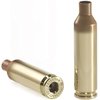According to Derek Peterson, president of Peterson Cartridge, “We decided to build the tooling to make .22 Creedmoor brass in response to the uptick in long-distance predator and varmint hunting. Plus the round is just straight-up fun to shoot. It is a low-recoil, flat shooting, wind-bucking round; deadly accurate up to 800 yards.” Peterson Cartridge also makes 6.5 and 6mm Creedmoor casings. “But when we designed the tooling for the .22 Creedmoor we set out to make casings with improved features,” Peterson stated. “And we were successful. We increased the head hardness to tolerate higher pressures. And we increased our internal volume slightly to work better with the slow burning powders (like RL 26, or H1000) which people favor for this round.” Prior to this, shooters had to take 6mm or 6.5 Creedmoor casings and neck them down to .22. There are a few problems with necking down. When you take a larger caliber with the correct neck wall thickness and neck it down to a smaller caliber, that excess brass bunches up in the neck. It creates a tension band, what some people call a doughnut of brass in the neck, which has a negative effect on loading, bullet release and accuracy. A trait of cartridge brass is that it work-hardens – which is to say the brass gets harder each time you “work it.” So the effect of necking down a casing which has been properly annealed, is that after you “work” it, it is no longer properly annealed. Finally, necking a larger caliber into a smaller one results in neck walls that are too thick. The ideal neck wall thickness for a case the size of .22 Creedmoor is .0143 to .0148. Necking down results in neck walls thicker than that. But the Peterson .22 Creedmoors all fall within that ideal spec. Peterson worked with Derrick Ratliff of Horizon Firearms on the particulars of the casing. Horizon has been chambering guns in .22 Creedmoor since 2014. Horizon has been a pioneer in helping move the .22 Crd. from an unknown wildcat to the popular caliber it is today.
¡Descubre la nueva munición .22 Creedmoor de Peterson Cartridge!
Según Derek Peterson, presidente de Peterson Cartridge, “Decidimos construir las herramientas para fabricar cartuchos de .22 Creedmoor en respuesta al aumento de la caza de depredadores y roedores a larga distancia. Además, disparar esta munición es simplemente divertido. Es un cartucho de bajo retroceso, de trayectoria plana y que desafía el viento; mortalmente preciso hasta 800 yardas.”
Peterson Cartridge también produce casquillos de 6.5 y 6mm Creedmoor. “Pero cuando diseñamos las herramientas para el .22 Creedmoor, nos propusimos crear casquillos con características mejoradas”, afirmó Peterson. “Y tuvimos éxito. Aumentamos la dureza de la cabeza para tolerar presiones más altas. Y aumentamos ligeramente nuestro volumen interno para funcionar mejor con los polvos de combustión lenta (como RL 26 o H1000) que la gente prefiere para este cartucho.”
Antes de esto, los tiradores tenían que tomar casquillos de 6mm o 6.5 Creedmoor y reducirlos a .22. Hay algunos problemas al hacer esta reducción. Cuando tomas un calibre más grande con el grosor de pared de cuello correcto y lo reduces a un calibre más pequeño, el exceso de latón se acumula en el cuello. Esto crea una banda de tensión, lo que algunas personas llaman un "doughnut" de latón en el cuello, que tiene un efecto negativo en la carga, la liberación de la bala y la precisión.
Una característica del latón de cartucho es que se endurece con el trabajo, es decir, el latón se vuelve más duro cada vez que lo “trabajas”. Así que el efecto de reducir el tamaño de un casquillo que ha sido adecuadamente recocido es que, después de “trabajarlo”, ya no está adecuadamente recocido. Finalmente, reducir un calibre más grande a uno más pequeño resulta en paredes de cuello que son demasiado gruesas. El grosor ideal de la pared del cuello para un casquillo del tamaño de .22 Creedmoor es de .0143 a .0148. La reducción resulta en paredes de cuello más gruesas que eso. Pero todos los .22 Creedmoor de Peterson se encuentran dentro de esa especificación ideal.
Peterson trabajó con Derrick Ratliff de Horizon Firearms en los detalles del casquillo. Horizon ha estado fabricando armas en .22 Creedmoor desde 2014 y ha sido pionero en ayudar a que el .22 Creedmoor pase de ser un cartucho desconocido a ser el calibre popular que es hoy.





